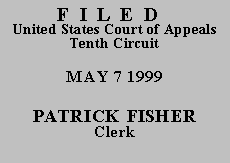 UNITED STATES COURT OF APPEALS
UNITED STATES COURT OF APPEALS
 UNITED STATES COURT OF APPEALS
UNITED STATES COURT OF APPEALS
TENTH CIRCUIT
| JESSE LEE JAMES, | |
| v. | No. 99-7005 |
| H.N. SCOTT, a/k/a "SONNY" SCOTT; ATTORNEY GENERAL OF THE STATE OF OKLAHOMA, | (D.C. No. 98-CV-421-S) |
ORDER AND JUDGMENT(*)
Before SEYMOUR, Chief Judge, BALDOCK, and HENRY, Circuit Judges.(**)
Petitioner Jesse Lee James appeals the district court's dismissal of his 28 U.S.C.
§ 2254 petition for a writ of habeas corpus as time-barred. The district court denied Petitioner's request for a certificate of appealability ("COA"). Petitioner's renewed application for a COA is pending before us. See 28 U.S.C. § 2253(c)(1). After carefully reviewing Petitioner's application for a COA, his brief and the record, we conclude that the district court correctly determined that the petition for habeas relief was time-barred under 28 U.S.C. § 2244(d).
Under § 2244(d)(1)(A), a habeas petition is time-barred if it is not filed within one year from the "date on which the judgment became final by the conclusion of direct review or the expiration of the time for seeking such review." Petitioner's conviction was affirmed by the Oklahoma Court of Criminal Appeals on May 14, 1996. In calculating the date on which direct review concluded, the district court cautiously included an additional ninety days, representing the period for filing a petition for certiorari to the United States Supreme Court. Thus, the district court determined that direct review of Defendant's conviction concluded, not on May 14, 1996, but on August 12, 1996. The district court should not have included the extra ninety days, however. See Maloney v. Poppel, 1999 WL 157428 at *2 (10th Cir. March 23, 1999) (unpublished). This oversight does not change the outcome because the petition remains time-barred.
Without the ninety-day period, Petitioner had one year from May 14, 1996, to file his habeas petition. Although this one-year period must be tolled while Petitioner pursued state post-conviction relief, see 28 U.S.C. § 2244(d)(2), the tolling provision does not apply in this case. This is so because Petitioner filed his application for post-conviction relief on August 6, 1997, nearly two months after the one-year limitation period expired. Because Petitioner did not file his federal habeas petition until August 21, 1998, well beyond the requisite one-year time period, the petition was untimely, and the district court properly refused to address the merits of Petitioner's claim. Accordingly, we DENY Petitioner's application for a certificate of appealability and DISMISS the appeal.
Entered for the Court,
Bobby R. Baldock
Circuit Judge
*. This order and judgment is not binding precedent, except under the doctrines of law of the case, res judicata, and collateral estoppel. The court generally disfavors the citation of orders and judgments; nevertheless, an order and judgment may be cited under the terms and conditions of 10th Cir. R. 36.3.
**. After examining the briefs and appellate record, this panel has determined unanimously to honor the parties' request for a decision on the briefs without oral argument. See Fed. R. App. P. 34(a)(2)(C). The case is therefore ordered submitted without oral argument.